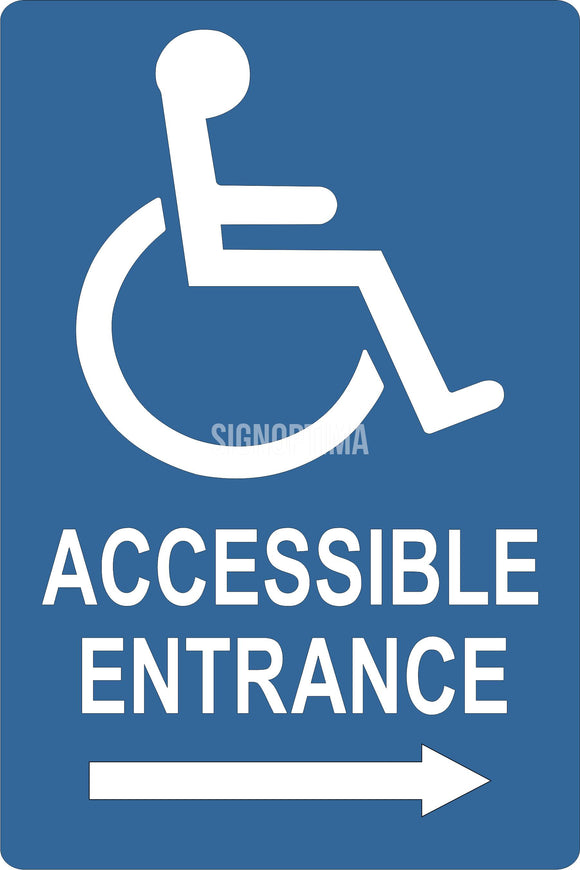How ADA Signs Boost Ease Of Access for Everyone
How ADA Signs Boost Ease Of Access for Everyone
Blog Article
ADA Signs: Making Sure Access and Conformity in Public Spaces
ADA signs plays an important function in assuring access and conformity within public rooms, significantly contributing to an inclusive setting for people with disabilities. As we explore the nuances of ADA signs, from responsive functions to create details, it's critical to take into consideration just how these components integrate to support the civil liberties of all customers.
Relevance of ADA Signs
In contemporary society, the importance of ADA signs prolongs past simple conformity with legal requireds to embody a dedication to inclusivity and access for all people. These signs are crucial in creating settings where people with specials needs can navigate public spaces with the very same ease and independence as those without handicaps. By offering standard and clear info, ADA signage guarantees that everybody can access facilities, solutions, and info without obstacles.
The relevance of ADA signage hinges on its ability to boost the lifestyle for people with handicaps by promoting equivalent access. It removes the challenges that might or else hinder their capacity to take part totally in neighborhood life. These indications offer as visible signs of an organization's dedication to variety and equality, mirroring more comprehensive societal values that champion the rights and dignity of all people.
Moreover, ADA signage plays a critical role in public safety and security. By leading people to exits, washrooms, and various other essential facilities, it ensures that all people, regardless of physical capacity, can evacuate securely during emergencies. In summary, ADA signs is not just a regulatory need however a powerful device for cultivating a fair and comprehensive society.
Trick Components of Conformity

Positioning is crucial; indicators have to be mounted in areas that are conveniently noticeable and obtainable. Generally, signage should be mounted in between 48 and 60 inches from the ground to make certain accessibility for both standing and wheelchair users. Responsive aspects, such as Braille, are crucial for individuals with aesthetic problems, supplying critical details in a non-visual format.
High-contrast shades between the text and background are required to boost readability for people with low vision. The ADA mandates particular contrast proportions to make sure clearness. Furthermore, character dimension is a crucial consideration, with minimum elevation demands dictated by the seeing distance to make certain readability from different angles.
Design Factors To Consider for Availability
Designing easily accessible signage requires a careful technique to guarantee it meets the requirements of all customers, specifically those with impairments. The dimension of the message is similarly critical, with ADA guidelines suggesting a minimal elevation based on viewing distance to make sure legibility.
Contrasting colors in between message and history are essential for exposure, especially for people with visual problems. A high comparison proportion aids distinguish the text from its background, enhancing readability under different lighting problems. Furthermore, responsive elements, such as Braille and raised characters, are vital for people who are blind or have reduced vision. These elements must be situated at a consistent height and placement to guarantee very easy gain access to and understanding.
Moreover, the positioning of signs plays a considerable role in accessibility. Indications should be installed in locations that are unblocked and quickly reachable. Making sure that signs is installed at proper elevations and angles enables all individuals, consisting of those making use of wheelchairs, to communicate with them effectively.
Usual Errors to Avoid

An additional prevalent error is the incorrect placement of signage. ADA guidelines specify specific height and area needs to make certain that indications are conveniently visible and reachable by all individuals, including those making use More about the author of wheelchairs. Overlooking these guidelines not only interferes with access yet likewise runs the risk of non-compliance with lawful requirements.
In addition, inadequate comparison between text and history is a regular oversight. Appropriate contrast is essential for readability, specifically for people with reduced vision. Designers often pick colors that are aesthetically enticing but do not have the essential contrast, providing the text challenging to discern.
Lastly, some developers stop working to incorporate responsive components, such as Braille, which are vital for individuals who are blind. Leaving out these features not only results in non-compliance with ADA policies yet also limits accessibility for a section of the population that counts on responsive information.
Future Trends in Signage
Developments in technology and enhancing understanding of inclusivity are shaping the future patterns in signs style. Digital signage, for circumstances, is evolving to include interactive features and real-time updates, which can be vital in supplying dynamic information in public rooms.
One more emerging fad is the usage of enhanced reality (AR) to boost individual experience. AR-enabled signs can overlay digital information onto the physical environment, providing aesthetically damaged people with auditory or haptic comments. ADA Signs. This technology not just boosts ease of access however likewise develops an engaging experience for all users
Sustainability is likewise a substantial factor affecting signage trends. Eco-friendly materials and energy-efficient lighting options are being focused on to align with international environmental goals. Advancements in products scientific research are leading to the growth of even more weather-resistant and resilient signs.
Conclusion
ADA signs plays an important duty in assuring access and compliance within public rooms by incorporating responsive aspects, high-contrast shades, and critical positioning. The adherence to ADA standards not just helps with safe navigating for individuals with disabilities yet also signifies an organization's dedication to diversity and inclusivity. By preventing usual blunders and embracing future fads, public rooms can remain to advance these values, making certain that the rights and self-respect of all individuals are valued and supported.
ADA signs plays an essential duty in ensuring ease of access and compliance within public spaces, considerably contributing to a comprehensive atmosphere for people with disabilities. As we discover the nuances of ADA signs, from why not try here tactile functions to create complexities, it's vital to consider just how these components coalesce to copyright the legal rights of all customers.In contemporary society, click reference the importance of ADA signs extends beyond mere compliance with legal requireds to symbolize a dedication to inclusivity and accessibility for all people. By providing standard and clear info, ADA signs guarantees that every person can access facilities, services, and details without obstacles.
ADA signage plays a crucial role in guaranteeing availability and compliance within public spaces by including responsive components, high-contrast shades, and calculated positioning. (ADA Signs)
Report this page